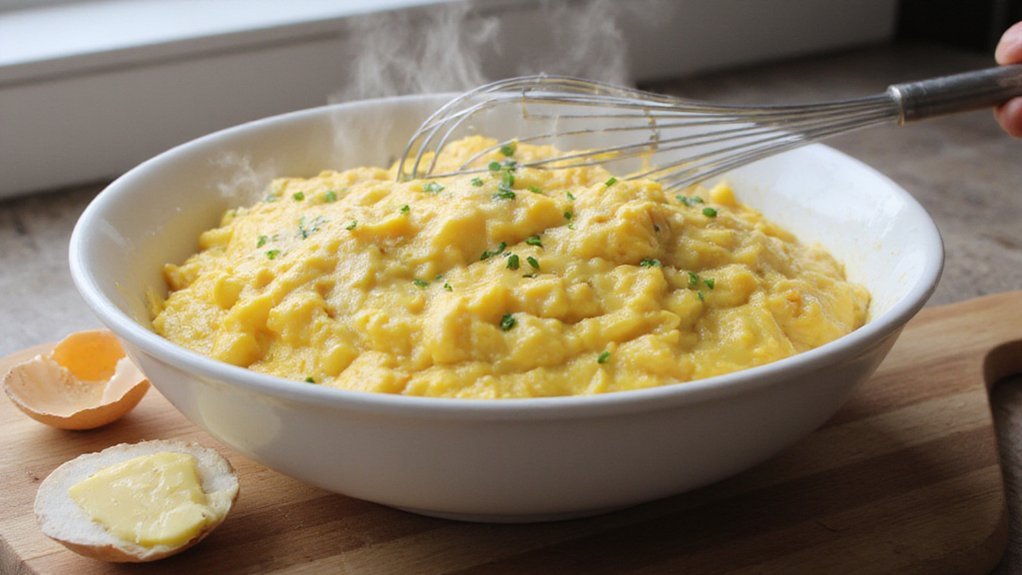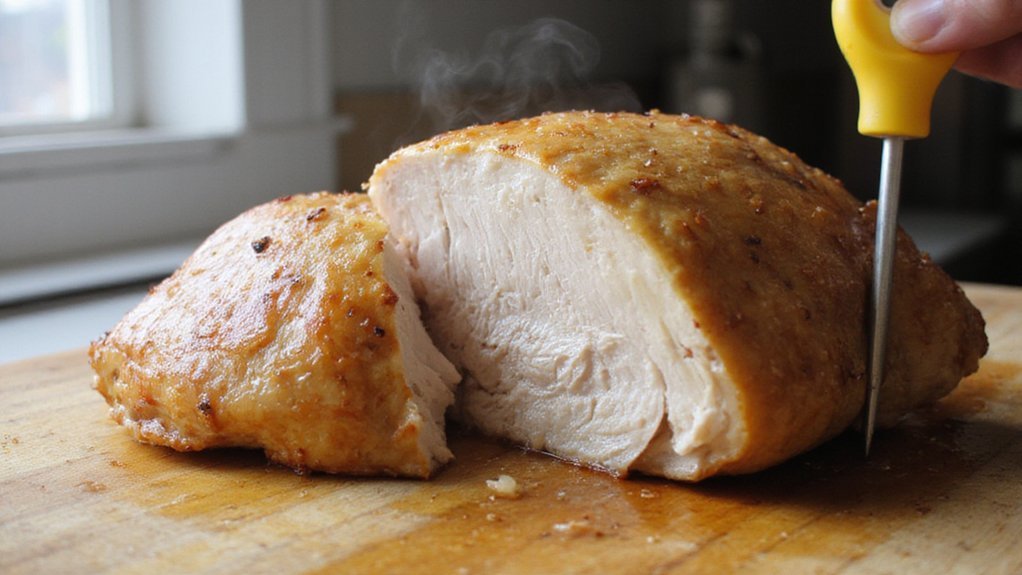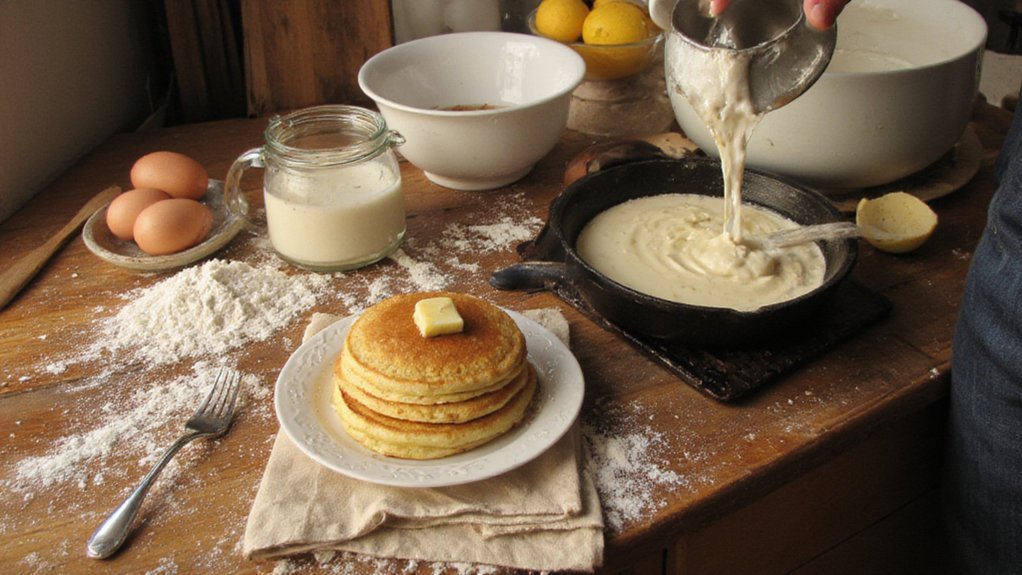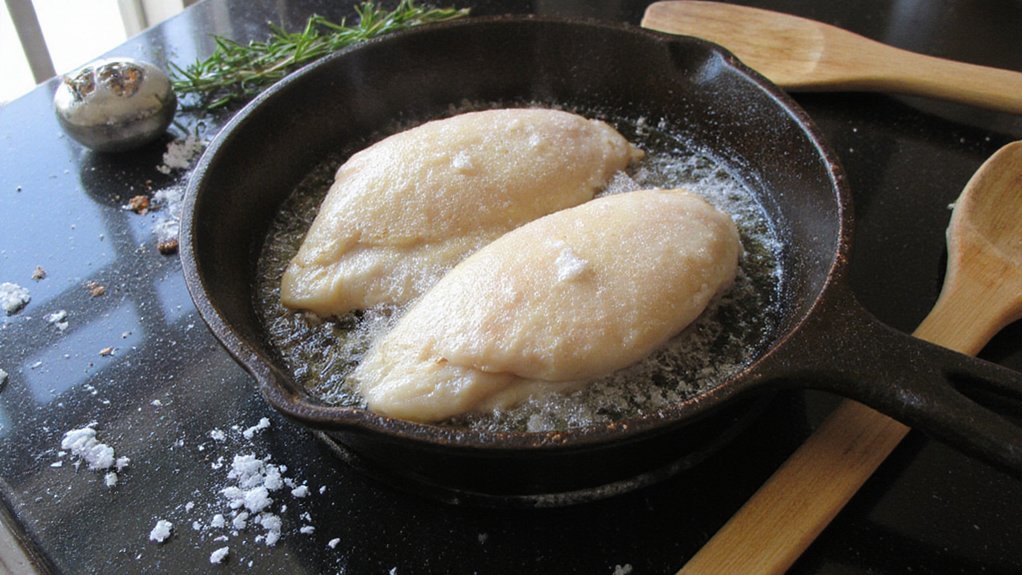If you want consistently fluffy scrambled eggs, you need control, not tricks. Use room-temperature eggs, whisk until airy, and cook low and slow in a nonstick pan while gently folding the curds. Avoid overcooking. There’s a simple sequence of whisking, fat, heat and timing that transforms texture—keep going to learn it.
Key Takeaways
- Use room-temperature eggs and whisk briskly to incorporate air until homogenous and lightly aerated.
- Avoid salting too early; add salt just before or after cooking to prevent moisture loss.
- Cook over low, steady heat and stir gently and frequently to form small, tender curds.
- Remove pan from heat when curds are glossy and slightly underdone, letting carryover finish them.
- Use an appropriately sized nonstick skillet and a flexible spatula to minimize mechanical stress on curds.
Common Mistakes That Make Scrambled Eggs Rubbery
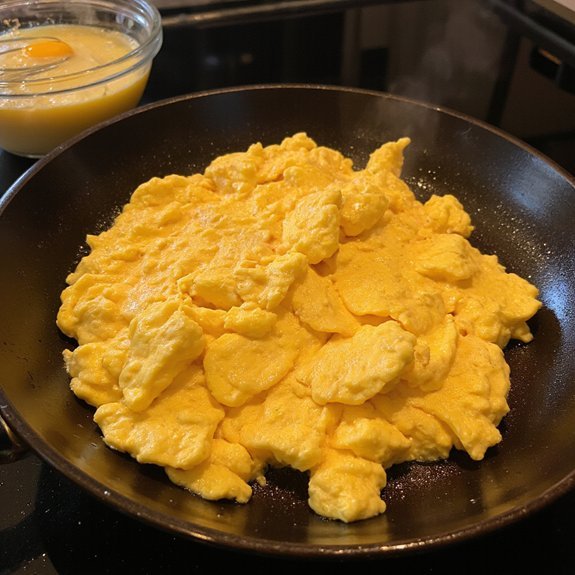
If you cook scrambled eggs over high heat or let them sit in the pan, the proteins tighten and the curds turn rubbery. You’ll avoid overcooking issues by controlling temperature and timing: cook low and slow, remove from heat while slightly underdone, and finish with residual carryover. Don’t stir once and then abandon the pan; frequent gentle folding yields small, tender curds. Beware improper seasoning—salting too early draws out moisture, altering texture; season at the end or use measured pre-mixers like diluted cream or butter to distribute salt without breaking curds. Use nonstick surfaces and a flexible spatula to minimize mechanical stress on curds. Taste frequently and adjust technique rather than piling on corrective ingredients. If you iterate intentionally—test one variable at a time—you’ll innovate efficiently, refine texture, and consistently produce creamy, non-rubbery scrambled eggs. Track results, document changes, and you’ll rapidly converge on your ideal method daily.
Essential Ingredients and Equipment
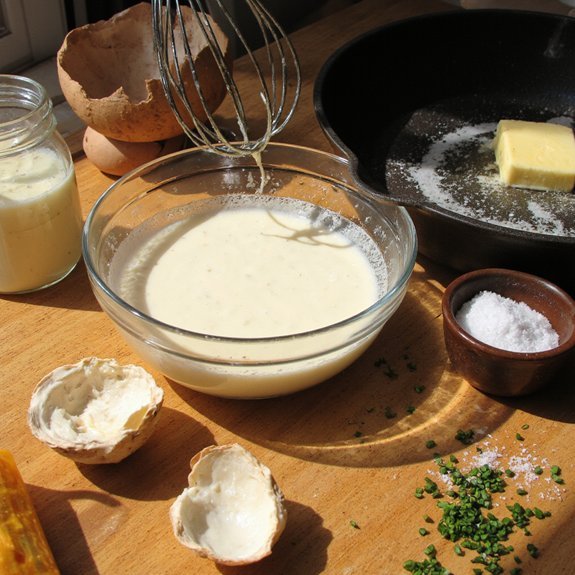
You’ll need high-quality, fresh eggs as the foundation for truly fluffy scrambled eggs. Use a whisk or fork to beat them thoroughly and a nonstick or well-seasoned skillet to cook gently. Have a silicone spatula, a heat-resistant bowl, and a low heat source ready to control texture and prevent overcooking.
Fresh Eggs
Fresh, properly stored eggs give you the best rise and creaminess in scrambled eggs. Choose farm fresh eggs when possible: their yolks are firmer and membranes stronger, which traps air during whipping for superior texture. Check egg quality by observing shell integrity, uniform color, and the sell-by date; a simple float test confirms freshness. Store eggs cold, pointy-end down, in their carton to preserve structure and prevent flavor transfer. For consistent innovation, source eggs with transparent farming practices and higher-grade feed—those inputs influence protein structure and mouthfeel. You’ll get fluffier, silkier curds when you start with top-tier eggs; the rest of your technique then amplifies, not compensates, for ingredient shortcomings. Treat each egg as an engineered component—measure, test, and standardize your source daily, now.
Tools and Cookware
While the egg is the star, you need precise tools: an 8–10-inch nonstick or well‑seasoned skillet for gentle, even heat; a flexible silicone spatula for soft folding; a whisk or fork to incorporate air; and a medium mixing bowl (or a shallow wide one) to spread and whip the eggs quickly. Choose non stick skillets with flat bottoms and responsive handles; they give predictable browning and easy release. Match pan size to portion to control cooking speed. Use low, even heat from reliable heat sources—induction or gas with accurate flame control—to avoid overcooking. Keep a lid nearby to finish custody with steam when needed. Calibrated timers, a thermometer, and small prep bowls let you iterate and innovate efficiently and refine technique regularly, measure results.
How to Whisk Eggs for Maximum Airiness
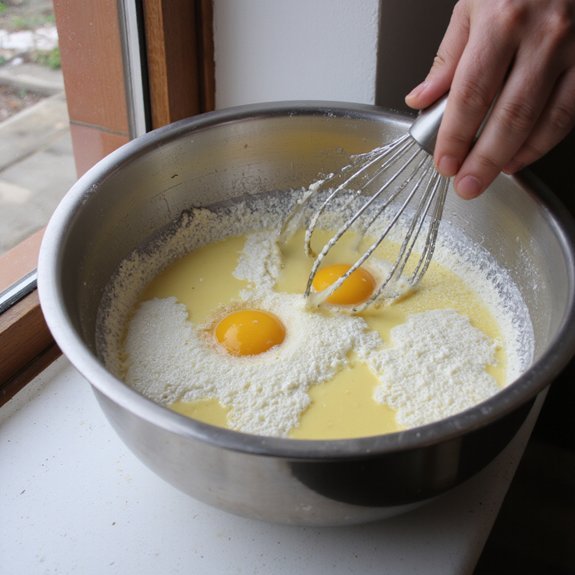
How do you get the most lift without collapsing the foam? You start with eggs at room egg temperature to trap air efficiently. Use rapid, controlled whisking techniques: a tight wrist motion with a balloon whisk creates uniform ribbons of air; pulse rather than frantic swirl to preserve structure. Tilt the bowl at 30 to 45 degrees so the whisk travels through more volume per stroke. Stop once the mixture is homogenous and lightly aerated—over-whisking deflates microspheres and yields rubbery curds. If you want extra loft, whisk in short bursts, folding between passes to redistribute pockets of air. Use a metal or glass bowl; plastic holds grease that undermines aeration. Aim for rhythm over speed: consistent strokes build stable foam without heat buildup. Transfer to a warm pan promptly so trapped air expands during cooking. These deliberate, repeatable actions produce maximum airiness while keeping texture tender and modern.
The Role of Milk, Cream, and Water
After you’ve aerated the eggs, the liquid you add will determine tenderness, silkiness, and how the curds form. Choose water for light, airy curds that stay delicate; it won’t dilute flavor and you’ll get fast coagulation. Add a splash of milk to boost creaminess without heaviness; explore milk alternatives like oat or almond for subtle sweetness and texture shifts. For maximum silk, use a small amount of cream — cream benefits include richer mouthfeel and smoother curds, but use sparingly to avoid dense eggs. Whisk liquids thoroughly into eggs so you’ll get uniform curd structure.
| Liquid | Effect | Use |
|---|---|---|
| Water | Light, airy curds | Quick, clean taste |
| Milk/milk alternatives | Creamier, flexible texture | Everyday balance |
| Cream | Rich, velvety curds | Small amount for luxury |
Adjust ratios experimentally: start with a teaspoon per two eggs and iterate, recording results to innovate your signature technique. Refine temperature control elsewhere in the process continuously.
Low-And-Slow Stove Method and Pan Choice
One key to custardy, tender curds is cooking eggs over low, steady heat and using a pan that gives you even temperature control. You’ll set a modest stove temperature, monitor gently, and make choices about pan material that influence thermal responsiveness and surface friction. A heavy-bottomed stainless or anodized aluminum pan spreads heat; nonstick reduces sticking; copper responds instantly if you want micro-adjustments. Choose a pan size that matches batch volume so heat distributes evenly. Control is innovation here: experiment within safe ranges to find the exact stove temperature that yields your preferred creaminess.
Low, steady heat and the right pan yield custardy, tender curds—experiment to find your ideal creaminess.
- Smooth sheen of butter melting across a wide stainless base
- Dull copper warming in a precise, immediate whisper
- Matte nonstick offering near-frictionless curd release
- Thick aluminum core absorbing and releasing heat slowly
- A pan rim retaining gentle steam around tender curds
Operate deliberately; low-and-slow plus the right pan material creates predictable, repeatable custard-like curds.
Folding, Timing, and Knowing When to Stop
You use a gentle folding motion with a silicone spatula to coax soft curds together without breaking them. Keep the heat low and fold every few seconds so the eggs set slowly and stay airy. Take the pan off the heat when the curds are still glossy and slightly underdone—carryover heat will finish them, so don’t wait for them to fully set.
Gentle Folding Technique
When the eggs just start to set at the edges, stop stirring and switch to gentle folds with a silicone spatula, sweeping from the pan’s edge toward the center to form large, custardy curds; fold slowly and deliberately, and pull the pan off the heat when the eggs are still slightly wetter than you want, since residual heat will finish them. Use gentle techniques to preserve air and moisture and to achieve perfect texture. You’ll see glossy, billowy curds that resist over-compaction. Innovate by varying fold size and timing while keeping heat low. Trust feel over timers: stop folding when curds hold shape yet gently wobble. Practice refines judgment; each batch teaches restraint and precision.
- glossy curd
- satin sheen
- pillowy folds
- slow sweep
- wobble
Remove Before Set
If the curds don’t leave the pan slightly underdone, residual heat will carry them past the window of silkiness into dryness. You stop folding when curds still glisten and jiggle — not raw, not set. Lift the pan from heat, fold gently twice, and let carryover finish; that’s remove before cooking in practice: intentional retreat to preserve texture. Time your final stir to match heat and volume; larger batches need a longer off-heat rest. You’ll feel when protein tension eases and moisture beads across curds. Trust sensory cues over clocks. These fluffiness tips prioritize controlled carryover and minimal agitation. You’ll deliver an innovative, airy result by mastering timing, decisive removal, and restraint. Practice a few iterations to calibrate heat, speed, and timing precisely, daily.
Quick Variations and Serving Ideas
How much difference can a few quick tweaks make to fluffy scrambled eggs? You can transform texture and flavor in minutes: fold in cream or a splash of milk for silkiness, beat air for loft, finish off-heat for custardy curds. Prioritize herb toppings, cheese variations, and a contrasting crunch to keep each bite interesting. Think modern: miso butter for umami, Labneh for tang, or smoked paprika oil for depth.
- Soft scrambled with chives and crème fraîche
- Folded with smoked cheddar and scallions
- Mediterranean: feta, oregano, tomato confit
- Asian twist: sesame oil, scallion, nori flakes
- Quick plate: arugula, lemon zest, toasted seeds
Serve on buttered sourdough, inside a warm tortilla, or atop a bowl of steamed rice. Experiment deliberately, taste constantly, and adjust temperature and timing to refine your signature approach. Aim for bold contrasts, subtle balance, and repeatable technique so your fluffy eggs become reliably exceptional every time.
